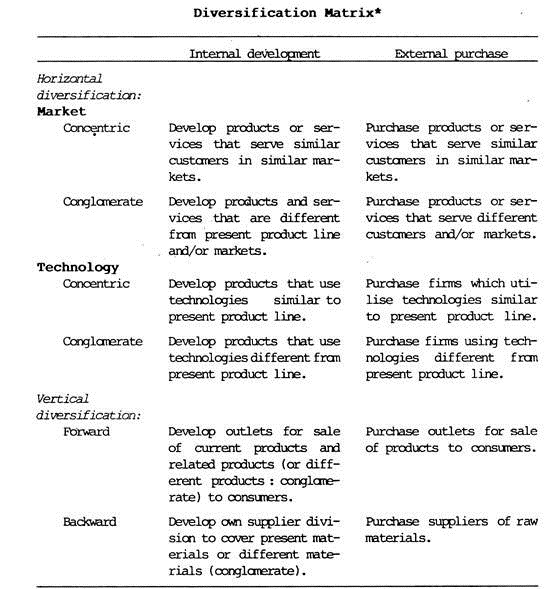In this article we will discuss about:- 1. Meaning of Product Diversification 2. Objectives of Product Diversification 3. Forms 4. Factors Motivating It .
Meaning of Product Diversification:
The term ‘product diversification’ is sometimes called ‘product differentiation’. Product diversification is a part of product line decisions’. The word diversification means that something new will be added.
It may refer to a new company, a new technology, a new market, or a new product. So, product diversification means addition of a new product (not the variations in the qualities of the same product) to the existing product line or mix.
It is important to note that conscious and deliberate product diversification, whether in the form of seeking new applications for the productive capacity and technological know-how of the firm on the one hand, or alternatively of exploiting a firm’s knowledge of a market which nay extend beyond its product range, is a matter of high-level management decision.
For example, manufacture and sale of sewing machines in addition to electric fans produced by a firm is a case of product diversification.
Objectives of Product Diversification:
According to Prof. Andrews, the different objectives of product diversification are:
1. To gain stability in the firm’s earnings and organisation.
2. To attain efficiency in the utilisation of a firm’s resources — human, physical and financial.
3. To increase sales of basic products and exploit the value of an established trade mark.
4. To increase the profits by offering different types of products.
5. To meet the demands and convenience of the diversified retailers.
6. To make profitable use of marketing opportunities.
Forms of Product Diversification:
There are several fonts or directions which a firm can follow for diversification. These are shown in the table below. Essentially the firms can diversify in a concentric way – close to present product/service lines – or quite differently from present product lines in marketing and/or technological ways (conglomerate diversification).
Thus, we find three distinct forms of product diversification;
(i) Diversification into related product-line,
(ii) Diversification into unrelated product line, and
(iii) Product replacement.
The development and marketing of ‘food articles’ in addition to the existing ‘detergents business’ carried on by Hindustan Lever Limited is an example of diversification into related product line. This is a kind of concentric diversification aiming at serving similar customers in similar markets. This is known as horizontal type of product diversification.
The development and marketing of different products like watches, tractors, bulbs, printing presses., etc., by Hindustan Machine Tools limited is an example of diversification into unrelated product lines. This is kind of conglomerate diversification in relation to the market.
The development and marketing of an entirely new product as an addition to the product line in order to replace a particular product of the same product line is known as product replacement. This form of product diversification is sometimes adopted by a firm as a defensive measure against the risk of dying out one of its products.
Factors that Motivate Product Diversification:
Product diversification is accentuated by the presence of the following main factors:
1. The development of science and technology offers scope for new products and causes obsolescence of old and existing products. The business firms having a strong technology base and high reputation in the field venture upon to enter into a new product line through the application of modern technological methods.
2. An efficient management of a firm is always on the lookout for doing new things. They believe that product diversification will help them avoid dangers of overspecialisation.
They think that development and marketing of new products, whether related or unrelated to the existing product line, will lead to the growth and stability of the firm. They see diversification as a way to convert internal cost centers into revenue producers’.
3. Industrial and economic policies of the Government encourage a firm to invest in its research and development and this leads to new products as a base for diversification.
4. The feeling that the economy (or market) in which the firm is operating is too small and confined to allow growth may prompt a firm to pursue the policy of product diversification.
5. The firm’s technology, research, and development produce products and by-products which appear to be outstanding.
6. The impact of social changes and development on the consumers’ behaviour, demand, fashion, and style motivates a firm towards product diversification.
